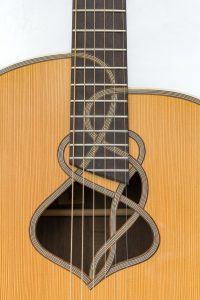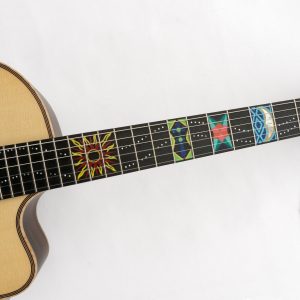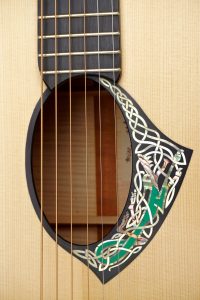 Wood inlay art is a type of woodworking technique that involves embedding small pieces of wood, often of different colors and types, into a larger piece of wood to create intricate designs or patterns. The process involves cutting the wood into thin strips or shapes, fitting them together precisely like a puzzle, and then gluing them in place.
Wood inlay art is a type of woodworking technique that involves embedding small pieces of wood, often of different colors and types, into a larger piece of wood to create intricate designs or patterns. The process involves cutting the wood into thin strips or shapes, fitting them together precisely like a puzzle, and then gluing them in place.
Inlay work can be used to decorate a variety of wood objects, including furniture, flooring, and musical instruments. The resulting designs can be simple or complex, and can range from geometric patterns to more elaborate scenes or images.
Wood Used In Inlay Work
Some common types of wood used in inlay work include ebony, rosewood, maple, cherry, and walnut, among others. The process of creating wood inlay art requires skill and precision, and it can take a great deal of time to complete a single project. However, the results can be stunning and can add a unique touch of beauty to any wood object.
Wood Inlay Art On Guitars
Wood inlay art is a popular technique used in the decoration of guitars. Inlay work on guitars is often used to enhance the aesthetics of the instrument and can range from simple designs to intricate patterns and scenes.
The most common area for inlay work on guitars is the fretboard. Inlay work on the fretboard can include simple dots or shapes, or more elaborate designs such as vines, flowers, or animals. Some guitar makers also use inlay work on the headstock, the back of the guitar, and the body of the instrument.
fretboard can include simple dots or shapes, or more elaborate designs such as vines, flowers, or animals. Some guitar makers also use inlay work on the headstock, the back of the guitar, and the body of the instrument.
The types of material used in inlay work on guitars can vary depending on the desired effect. Ebony, maple, rosewood, and mother of pearl are all popular choices for inlay work on guitars. In some cases, other materials such as abalone shell, turquoise, or other types of stone may be used as well.
Creating wood inlay art on guitars requires a high level of skill and precision, as the inlay work must be carefully fitted into the surface of the guitar without damaging the instrument. The result, however, is a beautifully crafted guitar that is not only a joy to play but also a work of art in its own right.
 In addition to the fretboard and headstock, wood inlay art can also be done on other areas of a guitar, such as the body, soundhole, pickguard, and even the bridge.
In addition to the fretboard and headstock, wood inlay art can also be done on other areas of a guitar, such as the body, soundhole, pickguard, and even the bridge.
On the body of the guitar, inlay work is often done around the edges, known as the binding. This can include simple lines or more intricate designs. Inlay work can also be done on the back of the guitar, typically in the center of the back or along the edges.
On acoustic guitars, inlay work can be done around the soundhole, adding an extra touch of elegance to the instrument. In some cases, inlay work may be done on the pickguard, either as a decorative element or to add the manufacturer’s logo or name.
Finally, some guitar makers may choose to add inlay work to the bridge of the guitar, which is the part of the instrument that holds the strings in place. This can include simple designs or more elaborate patterns, and can be done using a variety of materials such as mother of pearl or abalone shell.
Overall, wood inlay art can be done on a variety of areas of a guitar, and the possibilities for creativity and design are virtually limitless.
Other Items That Can Have Wood Inlays Added
Wood inlay art can be added to a variety of items to enhance their beauty and decorative appeal. Some of the most common items that can have wood inlay art added include:
- Furniture: Wood inlay art can be used to decorate furniture such as tables, chairs, cabinets, and dressers. Inlay work can be added to the table tops, drawer fronts, and even the legs of furniture.
- Jewelry boxes: Wood inlay art can be used to decorate the lids of jewelry boxes or to create intricate designs on the sides of the box.
- Musical instruments: In addition to guitars, wood inlay art can be added to other musical instruments such as violins, mandolins, and pianos.
- Picture frames: Wood inlay art can be added to the edges of picture frames, creating a unique and decorative border around the photo.
- Cutting boards: Wood inlay art can be added to the surface of cutting boards, adding a decorative element to a functional kitchen tool.
- Flooring: Inlay work can be added to hardwood flooring, creating intricate patterns and designs that add a touch of elegance to a room.
- Doors: Wood inlay art can be added to the surface of doors, creating a unique and decorative element in any room.
Overall, wood inlay art can be added to a wide range of items, allowing for endless possibilities for creativity and design.
Bone Inlays In Wood Items
Bone is often used in the creation of wood items to add structural support and durability. In woodworking, bone can be used in several ways:
Inlay work: Bone can be used in inlay work to create intricate designs and patterns on wood items. Inlay work typically involves cutting the bone into thin strips or shapes, which are then fitted into the wood and glued in place. The resulting designs can be simple or complex, and can range from geometric patterns to more elaborate scenes or images.
Joinery: Bone can be used in joinery to reinforce wood joints and add strength to the overall structure of a wood item. This is often done by creating small bone inserts that are fitted into the wood joint and secured with glue.
Decorative elements: Bone can be used as a decorative element on wood items, such as on the handles of knives, on musical instrument parts such as the nut or saddle, or as decorative inlays on furniture pieces.
Carvings: Bone can be carved into intricate shapes and designs, which can then be added to wood items to create unique decorative elements.
Overall, bone is a versatile material that can be used in many different ways to enhance the strength, durability, and beauty of wood items.